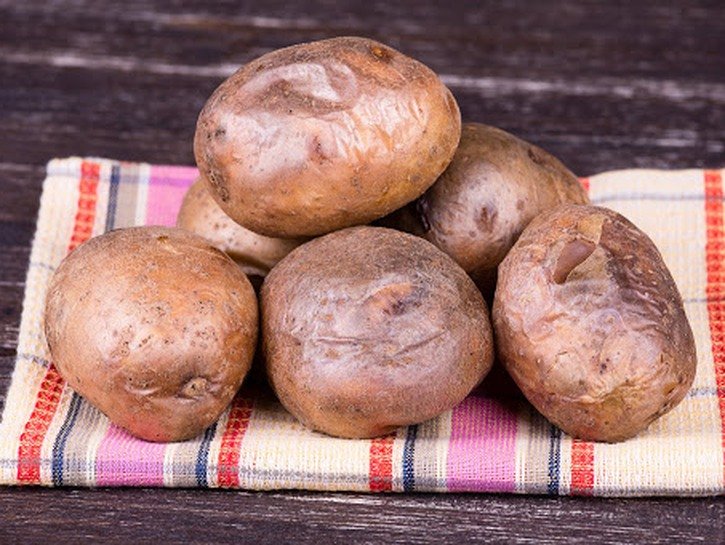Ahh, the humble baked potato. This culinary classic is a perfect side dish to round out any meal with a delicious starchy component. But, there’s a surprising amount of information out there for such a simple baked potato recipe. Luckily, we are here to wade through the details and share a foolproof guide to the best baked potato. We’ll discuss some common mistakes to avoid, the best potatoes for baking, additional pointers for great results, and a perfect baked potato recipe. You’ll never have to ask how to make baked potatoes ever again!
All About Baked Potatoes
Tips For Potato Perfection

Before we can tackle a recipe for baked potatoes, let’s first expand our knowledge of these spectacular spuds. It’s best to start with a solid foundation for success by using the proper type of potato, russet potatoes. These “Idaho potatoes” are long, starchy, brown and optimal for baking. For best results, this potato is king.
We’d also like to touch on the best way to prepare baked potatoes. While it’s far faster and easier to use a microwave, nothing compares to an oven baked potato. A microwave approach is much more likely to dry out your potato, both inside and out.
Common Mistakes To Avoid

It’s almost shocking how many ways there are to make an error with a simple baked potato. Here are some common issues for you to avoid the pitfalls of a less than successful spud.
- Proper Prep: Be sure to thoroughly rinse and wash potatoes since they are coming from under the ground. The last thing you want is to taste dirt or sand when you’re trying to enjoy a meal. After rinsing, be sure to completely dry the potato so it cooks properly, or the skin will not get crispy.
- Oil and Seasoning: It’s easy to not use enough of either of these crucial components. Oil helps to flavor the skin and crisp it up like a classic steakhouse potato, while seasoning is vital for good flavor. A bland baked potato is no one’s friend!
- Perfect Poke: It’s also important to remember to poke your potatoes before baking with a paring knife or fork at least a few times on each tuber. This helps ensure that they don’t pop or explode while baking as it allows steam to be released. If this step is skipped, the potato could make odd whistling noises and split while cooking which is bizarre and unappetizing.
- Patience Please: Lastly, it’s best to remember that a perfect potato is worth the wait. Cooking at 350 degrees, this will take an hour and up to ninety minutes. If you increase the temperature for a quicker result, your spud may end up getting dried out or cook unevenly with a burnt outside and hard innards.
The Perfect Baked Potato Recipe
Recipe
Ingredients
- 4 medium Russet potatoes
- salt to taste
- 1/4 cup olive oil
- 1/2 tablespoon ground black pepper
Supplies
- fork
- baking sheet
- veggie and fruit rinse
- colander
- dish towel
Directions
Begin by preheating your oven to 350 degrees. While that’s warming, cover potatoes with fruit and veggie rinse. Then, vigorously scrub to ensure that no dirt remains on your spuds. Use colander for the best rinse.
Next, thoroughly dry the potatoes using a clean dish towel and place them on a rimmed baking sheet. Poke each potato roughly four times with fork to let steam escape during baking process.
Next, use a generous amount of olive oil to rub all over potatoes; they should be covered completely. Add salt and pepper to taste after oiling, depending on your seasoning level preference.
Bake for about 70 minutes or until done, depending on your oven. A good indication of the potatoes being cooked appropriately is if they are easily pierced with a fork.
Once done, carefully remove from oven and enjoy with your favorite toppings.
Recipe Notes
For easier cleanup, consider lining baking sheet with parchment paper or aluminum foil.
Also, our preferred salt for this recipe is pink himalayan sea salt.
Variations

Now that we have mastered a basic baked potato, let’s discuss some cool modifications to add to your culinary repertoire. Besides the aforementioned olive oil, both canola oil and avocado oil can be used with great results for baked potatoes.
Additionally, while salt and pepper is a classic choice that pairs with any cuisine, other spices can ramp up the flavor depending on your planned meal. For example, consider Mexican spices like cumin or chili powder to pair with some spiced ground beef and a squeeze of zesty lime juice. Or, an Italian medley of spices featuring oregano and basil would be tasty with a classic steak and arugula combination. Get creative and play around with your spice cabinet until you find your new favorite combination.
Perhaps the best way to add variation to a baked potato is with the toppings. Some popular options to start are the classic butter or sour cream and chives. Other choices could be, melted cheddar with broccoli, or crumbled bacon and ranch. Additionally, baked potatoes are a great vehicle for leftovers such as a meaty red pasta sauce like bolognese, BBQ chicken or jackfruit, or leftover chili. All the yum!
